2. 中国科学院广州地球化学研究所有机地球化学国家重点实验室, 广州 510640
2. State Key Laboratory of Organic Geochemistry, Guangzhou Institute of Geochemistry, Chinese Academy of Sciences, Guangzhou 510640, China
卤代阻燃剂(halogenated flame retardants, HFRs)常被添加于电子、纺织和家具等商业品中[1~3], 主要包括溴代阻燃剂和氯代阻燃剂.随着多溴联苯醚(polybrominated diphenylethers, PBDEs)和多氯联苯(polychlorinated biphenyls, PCBs)等传统卤代阻燃剂的逐渐禁用[4], 新型卤代阻燃剂(new halogenated flame retardants, NHFRs)作为替代品被广泛使用[5, 6].例如, 得克隆常被用于油漆、纺织品、线路板以及电线连接器等产品中[6].2, 3, 4, 5-四溴-苯二羧酸双(2-乙基己基)酯和2-乙基己基-四溴苯甲酸以一定的比例混合, 主要用于电线、电缆绝缘材料以及粘合剂等[7].十溴二苯乙烷被广泛用于电脑、传真机、复印机、家电等的阻燃[6].这些新型卤代阻燃剂在生产、消费等全生命周期过程中易迁入环境中, 并在不同环境介质中赋存[8~11], 加之其具有持久性和生物蓄积性, 引起了普遍关注.
大气作为污染物扩散传输的主要途径之一, 在NHFRs的迁移中同样起着重要作用[12].国内已开展了一些大气NHFRs的相关研究[13~15], 然而目前还存在一些不足.首先, 许多研究中观测的NHFRs种类较少[16]; 其次, 以城市地区为对象的工作仍然有限, 且关于其来源的研究更少.城市作为人口和工业的聚集区, 阻燃剂的来源较其他地区更为复杂[17], 其大气中的NHFRs可能会直接影响人体健康, 甚至迁移至其他地区产生更严重的危害, 因此在典型地区开展NHFRs健康暴露和来源分析的研究具有重要意义.
本研究选取中国南部两个典型点位为研究区域:工业发达、人口密集的广州市, 毗邻电子垃圾拆解区(清远)和广东电子产品制造中心(东莞), 是典型的特大型城市; 背景地区五指山, 人口稀少, 远离工业污染源, 能代表区域大气的背景特征或情况.利用大流量主动采样器收集大气气相和颗粒相样品, 研究8种新型卤代阻燃剂的浓度水平、组成特征和季节变化, 分析其主要来源, 评价不同人群的暴露情况.
1 材料与方法 1.1 样点和采样信息于2013年11月~2014年6月(共8个月)在广东省广州市和海南省五指山, 在四周无明显障碍物的建筑顶楼(山顶)各布设一台大流量主动采样器(Tisch Environmental, Inc.), 收集大气气相和颗粒相样品, 各16个样本(气相+颗粒相), 具体采样信息见表 1.大气颗粒相样品用玻璃纤维滤膜(有效孔径为0.7 μm; Whatman, USA)采集, 在使用前于马弗炉中450℃煅烧8 h.大气气相样品用聚氨酯泡沫(PUF, 直径6.5 cm, 高7.5 cm, 密度0.030 g·cm-3)收集, 在使用前分别用二氯甲烷和丙酮索氏抽提48 h, 真空干燥后密封待用.在采样前后, PUF和石英棉用铝箔纸包裹置于密封袋中并在-20℃下保存.
|
|
表 1 采样点基本信息 Table 1 Basic information on the sampling sites |
1.2 样品前处理与分析
在采样后的PUF和玻璃纤维膜中加入20 ng的13C12-PCB138和13C12-PCB209作为回收率指示物.二氯甲烷索氏抽提36 h, 将提取液置于旋转蒸发器中浓缩并转换至1 mL正己烷溶液, 然后经层析柱(内径8 mm, 填充物从下到上依次是3g 3%的去活化氧化铝、3g 3%的去活化硅胶、3g 50%的硫酸硅胶、1 g的无水硫酸钠)净化.并用55 mL正己烷和二氯甲烷(1:1, 体积比)混合液淋洗, 舍去最初的15 mL淋洗液, 将剩余的40 mL淋洗液通过氮吹浓缩至约30 μL, 加入10 ng的13C-PCB141作为内标, 在-20℃下保存至分析.
采用气相色谱/质谱联用仪(Agient-5975 GC-MS)分析8种目标物:得克隆(dechlorane plus, DP)、2, 3, 4, 5-四溴-苯二羧酸双(2-乙基己基)酯[bis(2-ethylhexyl)tetrabromophthalate, TBPH]、五溴乙苯(pentabromoethylbenzene, PBEB)、六溴苯(hexabromobenzene, HBB)、1, 2-双(2, 4, 6-三溴苯氧基)乙烷[1, 2-bis(2, 4, 6-tribromophenoxy)ethane, TBE]、2-乙基己基-四溴苯甲酸(2-ethylhexyl tetrabromobenzoate, TBB)和十溴二苯乙烷(decabromodiphenyl ethane, DBDPE), 色谱柱为DB5-MS(柱长15 m, 内径0.25 mm, 液膜厚度0.25 μm), 电离模式为电子捕获负化学源.升温程序:110℃保持1 min, 以20℃·min-1速率升至200℃, 保持1 min, 以10 ℃·min-1的速率升至310℃, 保持12 min.离子源温度保持在280℃.
1.3 质量控制和质量保证在采样前进行了PUF和玻璃纤维膜的穿透实验, 在采样过程中为每个样品设置了野外空白, 在样品处理过程中设置了3个实验室空白.结果表明, 穿透实验下层PUF、野外空白和实验室空白样品中均无目标物检出.8种新型卤代阻燃剂的仪器检出限和方法检出限分别是0.11~0.38 pg·m-3和0.016~0.19 pg·m-3.样品的回收率是76.9%~111%, 目标物的浓度均未用回收率校正.
1.4 后向气流轨迹模型(HYSPLIT)HYSPLIT模型是由美国国家海洋和大气管理局(NOAA)和澳大利亚气象局研发, 被广泛用于各种污染物区域输送、扩散和传输等的研究中.本研究运用HYSPLIT-4, 结合NCEP/NCAR再分析项目的气象数据, 计算了采样期间到达广州和五指山样点的后向气流轨迹, 高度为样点的海拔高度(50 m和958 m), 时间为采样时刻之前的72 h.在轨迹分型模式下进行日轨迹聚类得到轨迹分型图.
2 结果与讨论 2.1 浓度组成广州和五指山大气(气相+颗粒相)∑NHFRs浓度范围分别为71.1~832 pg·m-3和27.7~132 pg·m-3; 其中6种新型溴代阻燃剂(∑NBFRs)的浓度范围分别是69.8~780 pg·m-3和26.3~125 pg·m-3; ∑DP的浓度为1.29~52.3 pg·m-3和0.30~7.22 pg·m-3.大气气相和颗粒相样品中NHFRs浓度水平见表 2.
|
|
表 2 广州和五指山大气(气相和颗粒相)NHFRs的浓度/pg·m-3 Table 2 Concentrations of atmospheric HNFRs(gas and particle phases) in Guangzhou and Wuzhishan/pg·m-3 |
与大多研究相似[18, 19], 广州大气(气相+颗粒相)中DBDPE为优势单体, 占大气中∑NHFRs的66.9%, 其平均浓度为224 pg·m-3, 高于哈尔滨、清远等地区[18, 20], 说明广州的DBDPE污染较严重.TBPH占广州大气中∑NHFRs的19.4%, 其他的NHFRs的占比均低于5%, 这与以前的广州地区NHFRs组成具有一定相似性[19].五指山的大气NHFRs组成特征则与广州明显不同, 以TBPH为主(65.8%), 这与以前研究中的天津、绵阳和太谷地区相似[19].而DBDPE占了∑NHFRs的24.8%, 其他阻燃剂的占比均未超过5%.
2.2 赋存状态和季节变化广州和五指山大气中8种NHFRs在气相和颗粒相中的分配比例(气相、颗粒相的平均质量浓度/大气平均质量浓度)如图 1所示.syn-DP、anti-DP和DBDPE在广州和五指山均以颗粒相为主, 与以往的大多数研究结果一致[21~23].而TBPH、PBEB和HBB则主要存在于气相中, 吴辉等[24]研究也发现PBEB和HBB主要分布在气相中.TBE和TBB在广州主要存在于颗粒相中, 而在五指山则以气相为主.Tian等[18]于2011年报道, 不同来源的颗粒物具有不同的吸附性, 这可能是导致地区大气TBE和TBB大气赋存状态不同的原因.
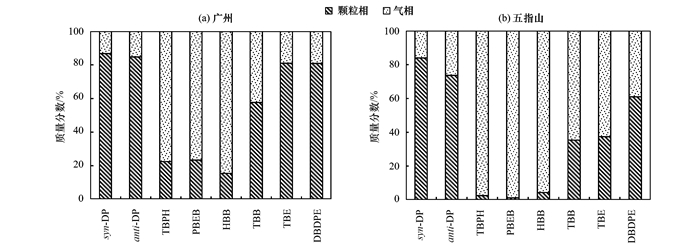
|
图 1 广州和五指山大气中NHFRs气粒占比 Fig. 1 Percentages of gas and particle phase NHFRs in Guangzhou and Wuzhishan |
从季节变化上看(如图 2), 广州有明显的季节变化, ∑NHFRs在12月和1月的浓度明显高于其他月份, 在2月浓度最低, 这与PM10的时间趋势相似(数据来源于中国环境保护部), 表明颗粒物的含量对∑NHFRs浓度有一定影响.此外, 2月低的NHFRs和颗粒物含量可能与春节期间停工有关.广州作为特大城市, 工业发达, 且毗邻清远(电子拆解产业发达)和东莞(电子产品制造业发达), 其颗粒物来源具有多样性.而五指山作为大气背景监测点, NHFRs浓度无明显的季节变化.
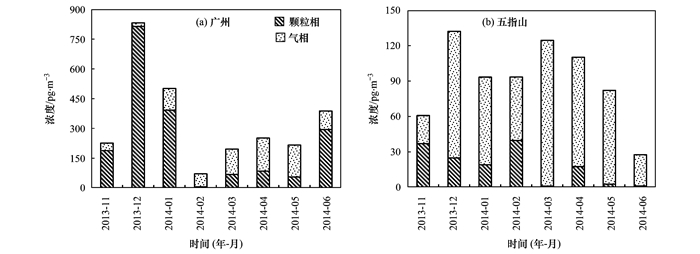
|
图 2 广州和五指山大气中气相和颗粒相NHFRs的季节变化 Fig. 2 Seasonal variations in the concentrations of gaseous and particulate NHFRs in Guangzhou and Wuzhishan |
为了研究广州和五指山不同样品间的差异性, 利用SPSS Statistics 22对大气(气相+颗粒相)中NHFRs的浓度数据进行标准化后, 以不同样品为自变量, 各阻燃剂浓度为应变量, 对NHFRs样品进行主成分分析[如图 3(a)].主成分1和主成分2分别占总变量的74.8%和24.4%.结果显示, 广州和五指山的样品具有显著差异.广州的大部分样品与主成分1有显著相关性, 而大多数五指山的样品则与主成分2正相关, 说明两地区大气阻燃剂可能来自不同源.结合风向频率(图 4)和后向气流轨迹模型分析结果(图 5), 在采样周期内, 广州地区的气团可能大多来自北部地区和西部区域(包括清远和东莞), 且这些地区分布有较多的电子电器生产企业和电子垃圾拆解产业; 少部分气团来自南方.这表明广州市大气阻燃剂可能主要来源于周边地区消费品再挥发、工业生产和电子垃圾拆解[18, 25].而五指山的气团主要来自珠江三角洲的西南地区和海上, 还有小部分来自东南亚, 加之五指山人口稀少, 远离工业源, 推测其阻燃剂可能主要来自外来源.
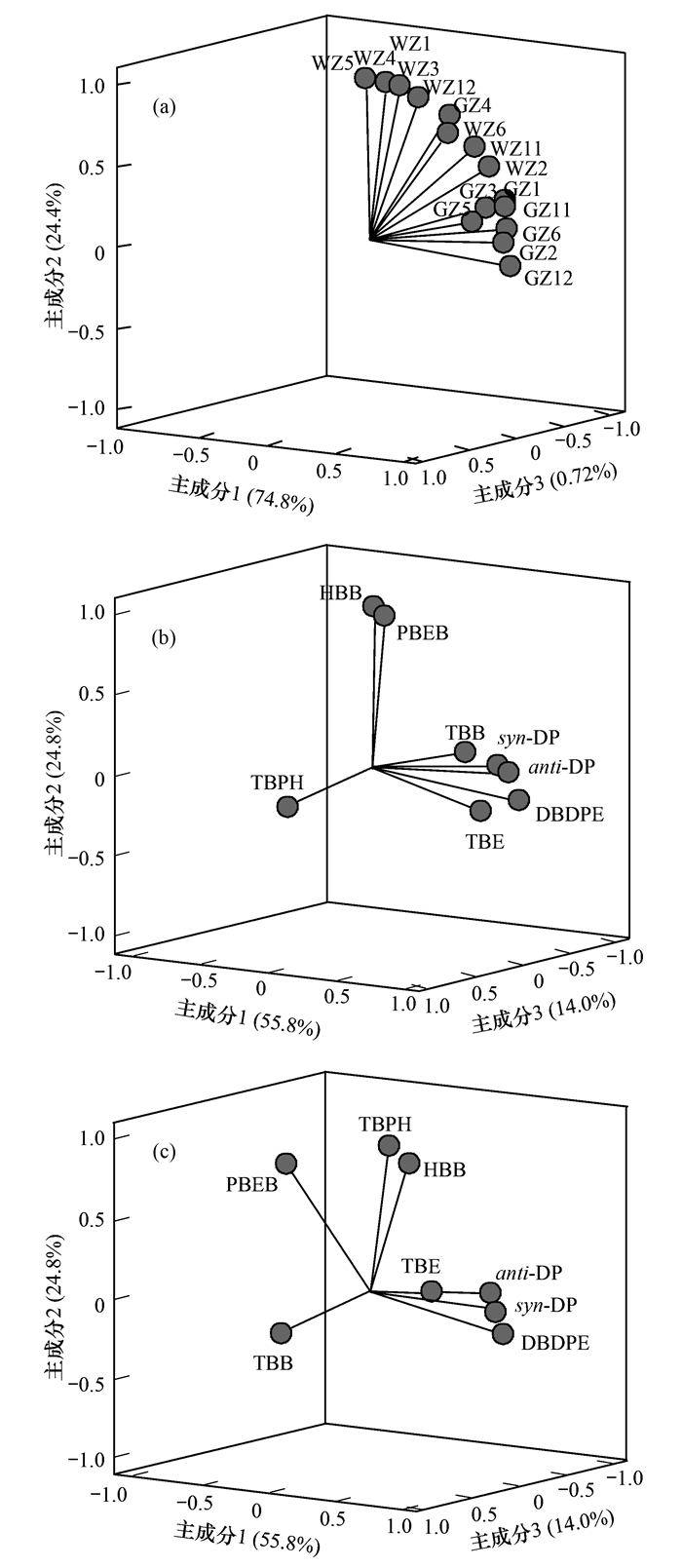
|
(a)广州和五指山样品, (b)广州大气阻燃剂, (c)五指山大气阻燃剂 图 3 广州和五指山大气(气相+颗粒相)中NHFRs的主成分分析 Fig. 3 Principle component analysis(PCA) of atmospheric (gas plus particle phase) NHFRs in Guangzhou and Wuzhishan |
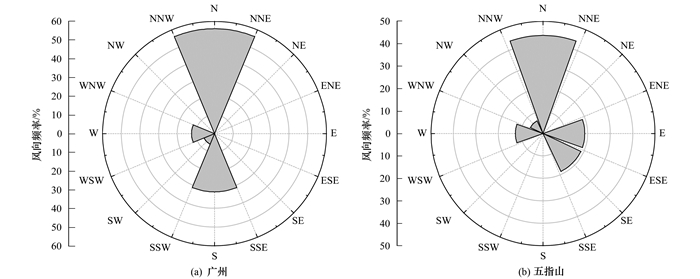
|
图 4 广州和五指山采样周期风向频率玫瑰图 Fig. 4 Frequency distribution of wind direction in Guangzhou and Wuzhishan during the sampling period |
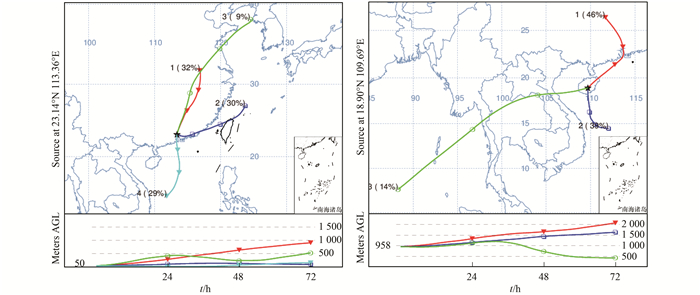
|
图 5 广州和五指山全采样周期后向轨迹分析结果 Fig. 5 HYSPLIT analysis results in Guangzhou and Wuzhishan during the entire sampling period |
为了研究NHFRs化合物之间的关系, 以阻燃剂的浓度水平为自变量, 不同的样品为应变量, 对两地阻燃剂浓度分别进行主成分分析.如图 3(b)所示, 广州大气中NHFRs分成3个集群.TBB、syn-DP、anti-DP、TBE和DBDPE与主成分1(55.8%)有明显的正相关, 其均常被用于电子产品中, 推测可能来自于电子垃圾拆解或相关工业的释放.HBB和PBEB则与主成分2(24.8%)显著相关, 结合早期研究的观点:HBB与人口正相关, PBEB与纺织、造纸等产业正相关[19], 推测其可能来源于消费品的再挥发.TBPH与主成分3(14.0%)有明显的相关性, 不同于HBB和PBEB, 可能来自相关商业品生产和使用中释放.与广州相似, 五指山[如图 3(c)]的syn-DP、anti-DP和DBDPE与主成分1(55.8%)正相关, PBEB和HBB与主成分2(24.8%)显著相关, 可能来自于周边地区的相似源或外源输入.而TBPH和TBB的载荷值与广州明显不同, 可能是由于广州和五指山相关商业品的生产、消费结构有差异.五指山的TBE与3个主成分均无正相关关系, 表明其可能退出市场, 来源于大气残留[19].
2.4 健康暴露大气中的污染物能通过多种暴露途径影响人体健康, 其中呼吸吸入是最直接的暴露方式.城市地区密集的人口, 高浓度NHFRs中的持续暴露可能对人群有潜在风险.本研究参照美国国家环境保护局(EPA)暴露模型计算了广州站点周围不同人群对室外大气中NHFRs的日暴露量[26].公式如下:

|
(1) |
式中, DD为日暴露量[pg·(kg·d)-1]; c为污染物浓度(pg·m-3); IR为呼吸速率(m3·d-1); ED为室外暴露持续时间(取0.33 d); BW为体重(kg).人体相关数据均来自文献[27].
结果如表 3所示, 广州大气NHFRs日暴露量为21.7~61.9 pg·(kg·d)-1.从不同人群上看, 除成年男性外, 女性的日暴露量均略高于男性; 从年龄段上看, 婴儿的日暴露量远高于其他年龄段, 随着年龄的增大, 人体的日暴露量呈现下降趋势.目前有关大气NHFRs健康暴露的研究仍然较少, 随着我国城市大气中NHFRs浓度的升高[19], 其对居民健康的潜在危害不容忽视, 应继续开展相关研究.
|
|
表 3 广州大气NHFRs的日暴露量 Table 3 Daily doses of atmospheric NHFRs in Guangzhou |
3 结论
(1) 广州和五指山大气中8种新型卤代阻燃剂浓度范围分别为71.1~832 pg·m-3和27.7~132 pg·m-3.syn-DP、anti-DP和DBDPE主要存在于颗粒相中, TBPH、PBEB和HBB均主要存在于气相中.广州的∑NHFRs浓度呈现一定季节变化, 五指山的∑NHFRs则无明显季节变化, 这可能与两地NHFRs的来源不同有关.
(2) 广州和五指山大气中NHFRs来源存在较大差异, 广州的阻燃剂可能主要来源于消费品再挥发、电子垃圾拆解和工业输入, 而五指山大气中的阻燃剂可能主要来自外源输入.
(3) 广州大气NHFRs的日暴露量高于五指山, 女性的日暴露量略高于男性(除成人外), 婴儿的日暴露远高于其他年龄段, 表明城市大气NHFRs对婴儿的潜在健康危害更大.
| [1] | Diamond M L, Melymuk L, Csiszar S A, et al. Estimation of PCB stocks, emissions, and urban fate:will our policies reduce concentrations and exposure?[J]. Environmental Science & Technology, 2010, 44(8): 2777-2783. |
| [2] | Alaee M, Arias P, Sjödin A, et al. An overview of commercially used brominated flame retardants, their applications, their use patterns in different countries/regions and possible modes of release[J]. Environment International, 2003, 29(6): 683-689. DOI:10.1016/S0160-4120(03)00121-1 |
| [3] | Xian Q M, Siddique S, Li T, et al. Sources and environmental behavior of dechlorane plus-a review[J]. Environment International, 2011, 37(7): 1273-1284. DOI:10.1016/j.envint.2011.04.016 |
| [4] |
陈来国, 麦碧娴, 许振成, 等. 广州市夏季大气中多氯联苯和多溴联苯醚的含量及组成对比[J]. 环境科学学报, 2008, 28(1): 150-159. Chen L G, Mai B X, Xu Z C, et al. Comparison of PCBs and PBDEs concentrations and compositions in the Guangzhou atmosphere in summer[J]. Acta Scientiae Circumstantiae, 2008, 28(1): 150-159. |
| [5] | Vorkamp K, Bossi R, Rigét F F, et al. Novel brominated flame retardants and dechlorane plus in Greenland air and biota[J]. Environmental Pollution, 2015, 196: 284-291. DOI:10.1016/j.envpol.2014.10.007 |
| [6] |
郑晓波. 卤代有机污染物在鸡中的富集、子代传递和胚胎发育中的迁移转化及体外代谢[D]. 广州: 中国科学院研究生院(广州地球化学研究所), 2015. 1-20. Zheng X B. Organohalogenated pollutants in bioaccumulation, maternal transfer, and embryo development processes of chicken and in vitro metabolism[D]. Guangzhou: Guangzhou Institute of Geochemistry, Chinese Academy of Sciences, 2015. 1-20. |
| [7] | Qi H, Li W L, Liu L Y, et al. Levels, distribution and human exposure of new non-BDE brominated flame retardants in the indoor dust of China[J]. Environmental Pollution, 2014, 195: 1-8. DOI:10.1016/j.envpol.2014.08.008 |
| [8] | Covaci A, Harrad S, Abdallah M A E, et al. Novel brominated flame retardants:a review of their analysis, environmental fate and behaviour[J]. Environment International, 2011, 37(2): 532-556. DOI:10.1016/j.envint.2010.11.007 |
| [9] | Shi T, Chen S J, Luo X J, et al. Occurrence of brominated flame retardants other than polybrominated diphenyl ethers in environmental and biota samples from southern China[J]. Chemosphere, 2009, 74(7): 910-916. DOI:10.1016/j.chemosphere.2008.10.047 |
| [10] | Zheng Q, Nizzetto L, Li J, et al. Spatial distribution of old and emerging flame retardants in Chinese forest soils:sources, trends and processes[J]. Environmental Science & Technology, 2015, 49(5): 2904-2911. |
| [11] | Hu G C, Luo X J, Dai J Y, et al. Brominated flame retardants, polychlorinated biphenyls, and organochlorine pesticides in captive giant panda (Ailuropoda melanoleuca) and red panda (Ailurus fulgens) from China[J]. Environmental Science & Technology, 2008, 42(13): 4704-4709. |
| [12] | Xiao H, Shen L, Su Y S, et al. Atmospheric concentrations of halogenated flame retardants at two remote locations:the Canadian High Arctic and the Tibetan Plateau[J]. Environmental Pollution, 2012, 161: 154-161. DOI:10.1016/j.envpol.2011.09.041 |
| [13] | Salamova A, Hites R A. Discontinued and alternative brominated flame retardants in the atmosphere and precipitation from the great lakes basin[J]. Environmental Science & Technology, 2011, 45(20): 8698-8706. |
| [14] | Venier M, Hites R A. Flame retardants in the atmosphere near the Great Lakes[J]. Environmental Science & Technology, 2008, 42(13): 4745-4751. |
| [15] | Ma Y N, Salamova A, Venier M, et al. Has the phase-out of PBDEs affected their atmospheric levels? Trends of PBDEs and their replacements in the Great Lakes atmosphere[J]. Environmental Science & Technology, 2013, 47(20): 11457-11464. |
| [16] | Zhao Y F, Ma J, Qiu X H, et al. Gridded field observations of polybrominated diphenyl ethers and decabromodiphenyl ethane in the atmosphere of north China[J]. Environmental Science & Technology, 2013, 47(15): 8123-8129. |
| [17] |
张宏莉, 仇雁翎, 葛元新, 等. 中国大气环境中溴代阻燃剂污染特征研究进展[J]. 环境科学与技术, 2016, 39(3): 192-199. Zhang H L, Qiu Y L, Ge Y X, et al. Study progress on pollution characteristics of brominated flame retardants (BFRs) in China atmospheric environment[J]. Environmental Science & Technology, 2016, 39(3): 192-199. |
| [18] | Tian M, Chen S J, Wang J, et al. Brominated flame retardants in the atmosphere of e-waste and rural sites in southern China:seasonal variation, temperature dependence, and gas-particle partitioning[J]. Environmental Science & Technology, 2011, 45(20): 8819-8825. |
| [19] | Li Q L, Yang K, Li K C, et al. New halogenated flame retardants in the atmosphere of nine urban areas in China:pollution characteristics, source analysis and variation trends[J]. Environmental Pollution, 2017, 224: 679-688. DOI:10.1016/j.envpol.2017.02.052 |
| [20] | Qi H, Li W L, Liu L Y, et al. Brominated flame retardants in the urban atmosphere of Northeast China:concentrations, temperature dependence and gas-particle partitioning[J]. Science of the Total Environment, 2014, 491-492: 60-66. DOI:10.1016/j.scitotenv.2014.03.002 |
| [21] | Sverko E, Tomy G T, Reiner E J, et al. Dechlorane plus and related compounds in the environment:a review[J]. Environmental Science & Technology, 2011, 45(12): 5088-5098. |
| [22] | Salamova A, Hites R A. Dechlorane plus in the atmosphere and precipitation near the Great Lakes[J]. Environmental Science & Technology, 2011, 45(23): 9924-9930. |
| [23] | Liu L Y, Salamova A, Venier M, et al. Trends in the levels of halogenated flame retardants in the Great Lakes atmosphere over the period 2005-2013[J]. Environment International, 2016, 92-93: 442-449. DOI:10.1016/j.envint.2016.04.025 |
| [24] |
吴辉, 金军, 王英, 等. 典型地区大气中多溴联苯醚和新型溴代阻燃剂的水平及组成分布[J]. 环境科学, 2014, 35(4): 1230-1237. Wu H, Jin J, Wang Y, et al. Comparative study of the level and distribution of polybrominated diphenyl ethers and new brominated flame retardants in the atmosphere of typical urban[J]. Environmental Science, 2014, 35(4): 1230-1237. |
| [25] | Yang R Q, Zhang S J, Li X H, et al. Dechloranes in lichens from the southeast Tibetan Plateau:evidence of long-range atmospheric transport[J]. Chemosphere, 2016, 144: 446-451. DOI:10.1016/j.chemosphere.2015.09.011 |
| [26] | EPA. Exposure factors handbook:2011 edition[M]. Washington, DC: National Center for Environmental Assessment, 2011: 14-16. |
| [27] |
王宗爽, 段小丽, 刘平, 等. 环境健康风险评价中我国居民暴露参数探讨[J]. 环境科学研究, 2009, 22(10): 1164-1170. Wang Z S, Duan X L, Liu P, et al. Human exposure factors of Chinese people in environmental health risk assessment[J]. Research of Environmental Sciences, 2009, 22(10): 1164-1170. |
 2018, Vol. 39
2018, Vol. 39

